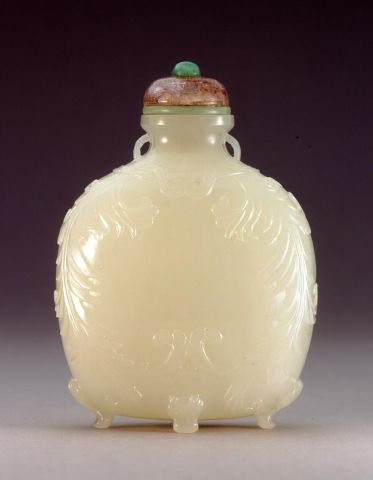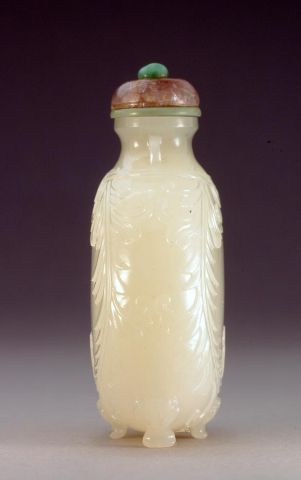

Bottle ID: 172
IMPERIAL, MOGHUL STYLE WITH FEET
Date: 1750-1795
Height: 65 mm
Nephrite, the translucent stone of even white tone, very well hollowed, of flattened rounded form with rounded shoulders sloped to a waisted neck with a wide mouth with straightened lip, with two small handles on the neck, the bottle supported by four small feet issuing from lion masks, and carved in low relief in Moghul style, on each main side with a pair of formal scrolling fern stems suspended from a ribbon around the shoulder,
Imperial, attributed to the Tibetan Palace Workshops (Xifanzuo), Beijing.
Similar Examples:
Crane Collection no. 283
Perry, Lilla S. Chinese Snuff Bottles: The Adventures & Studies of a Collector, 1960, p. 104, no. 82.
Moss, Hugh, Victor Graham and Ka Bo Tsang. A Treasury of Chinese Snuff Bottles - The Mary and George Bloch Collection, 1995, Vol. 1, pp. 284-287, no. 115.
Sotheby's, New York, April 1, 2005, lot 383, Collection of Avrina Pugh.
Provenance:
Clare Lawrence Ltd.
Christie's Swire, Hong Kong, March 22, 1993, lot 510
Mr. K. Chiu, London
Sotheby's, London, October 13, 1987, lot 134
Eric Young
Sotheby's, New York, June 25, 1982, lot 154
Bob C. Stevens
Exhibited:
An Exhibition of Chinese Snuff Bottles and Dishes from the Bob C. Stevens Collection, Mikimoto Hall, Tokyo, 22-31 October, 1978
Published:
JICSBS, Summer 1993, p. 26, fig. 3
JICSBS, Winter 1987, p. 31, fig. 17
JICSBS. December 1978, p. 43, fig. 166
Catalogue of an Exhibition of Chinese Snuff bottles and Dishes from the Bob C. Stevens Collection, Mikimoto Hall, Tokyo, 22-31 October, 1978, p. 66, no. 166
Stevens, Bob C. The Collector's Book of Snuff Bottles, 1976, p. 282, no. 1013
From the eleventh century onwards the Moghuls enjoyed an artistic heyday. One popular style of carving resembled is shown here, with lotus petals and foliage carved in a delicate manner. The nephrite used for these pieces was generally of a pale celadon-green or a dark spinach green. The Qianlong Emperor received a large number of gifts at court from the Moghuls including jade wares and developed a fondness for this style. This resulted in a number of Chinese pieces being made which stylistically emulated the Moghul wares seen in the Palace.
< Back to full list
 English
English 中文
中文